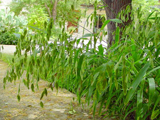Native Plants

Q. Who is Mr. Smarty Plants?
A: There are those who suspect Wildflower Center volunteers are the culpable and capable culprits. Yet, others think staff members play some, albeit small, role. You can torture us with your plant questions, but we will never reveal the Green Guru's secret identity.
Did you know you can access the Native Plant Information Network with your web-enabled smartphone?
Ask Mr. Smarty Plants is a free service provided by the staff and volunteers at the Lady Bird Johnson Wildflower Center.

rate this answer
Saturday - July 26, 2008
From: Pleasant Hill, MO
Region: Midwest
Topic: Erosion Control
Title: Erosion control near creek in Kansas City, MO
Answered by: Nan Hampton
QUESTION:
I'm looking for something to plant to help stop erosion on my property. The spot I have in mind is on a slight natural grade heading toward the creek at the back of my property. Any ideas on what to plant - it is in a fairly shady spot? I live near Kansas City Missouri. Someone suggested daylilies - but don't they need a lot of sun?ANSWER:
First of all, daylilies (Hemerocallis spp.) are native to Europe and Asia and not native to North America. Since what we are all about here at the Lady Bird Johnson Wildflower Center is "to increase the sustainable use and conservation of native wildflowers, plants and landscapes", Mr. SP wouldn't recommend planting daylilies. Besides, you are right that they do best in full sun.Grasses and sedges work well for erosion control because of their fibrous root systems that hold the soil and we can recommend several shade-loving ones that are native to Missouri.
Carex blanda (eastern woodland sedge) sun, part shade, shade and dry to moist soils, evergreen
Carex cherokeensis (Cherokee sedge) part shade and wet or moist soils, evergreen
Carex pensylvanica (Pennsylvania sedge) sun, part shade, shade and dry to moist soils, evergreen
Carex texensis (Texas sedge) sun, part shade and dry to moist soils
Chasmanthium latifolium (Inland sea oats) part shade, shade and dry to moist soils
Elymus canadensis (Canada wildrye) sun, part shade, shade and dry to moist soils
Eragrostis intermedia (plains lovegrass) part shade and dry soils
Schizachyrium scoparium (little bluestem) sun, part shade and dry soils
You could also use ferns.
Asplenium platyneuron (ebony spleenwort) part shade, shade and dry to moist soils, evergreen
Athyrium filix-femina (common ladyfern) part shade, shade and moist to wet soils
Osmunda cinnamomea (cinnamon fern) part shade and moist to wet soils
Polystichum acrostichoides (Christmas fern) sun, part shade and dry to moist soils, evergreen
After your soil is stabilized by using the grasses, sedges, and/or ferns, you could also add wildflowers to the mix. You can find a list of commercially available native plants recommended for landscaping by choosing Missouri from the map on our Recommended Species page.
More Erosion Control Questions
Ground cover for Connecticut sandy gravel bank
January 11, 2012 - What ground cover plant can I use on a sandy gravel bank behind my house?
view the full question and answer
Groundcover for erosion control
July 22, 2008 - I have a sloped area in my back yard where we need to plant some erosion control plants. The area is above a large (100 foot long x 4 foot tall) stone wall and another smaller wall of natural stone. ...
view the full question and answer
Low plants to cover bank too steep to mow
June 26, 2008 - I have a bank along the road that is too steep to mow. This bank faces east and only gets 2 - 4 hours per day of sunlight. I'd like to try ground cover to prevent erosion, however visibility is a p...
view the full question and answer
Low-growing plants for steep bank to prevent erosion
March 24, 2010 - We recently bought a house (6 months ago) in Memphis, TN that backs up to a concrete drainage ditch. There is a fairly steep, mostly shaded bank that leads from the flat section of the back yard to th...
view the full question and answer
Reconsideration of previous question from Hays County TX
February 21, 2014 - QUESTION:
Please reconsider this question that I sent to you last week. Our home address is in Bastrop County, but the Blanco River property that we own is in Hays County near Wimberley.
Our proper...
view the full question and answer
| Support the Wildflower Center by Donating Online or Becoming a Member today. |

